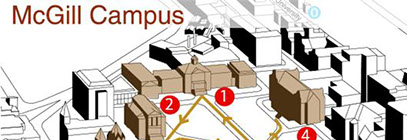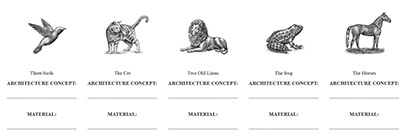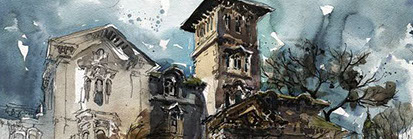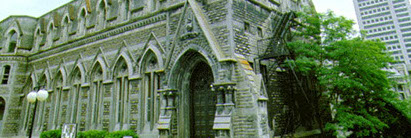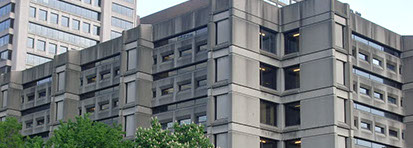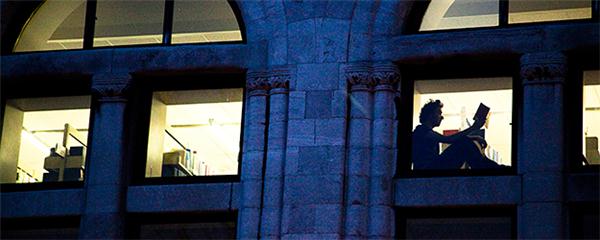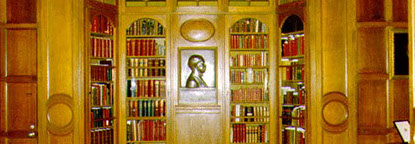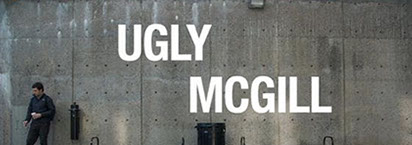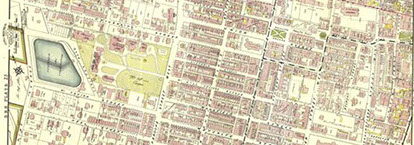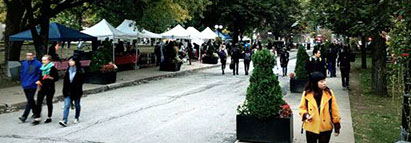Course Description
Knowledge intuitions such as schools, college campuses, museums, archives, public libraries are particularly suited to studying “architectural networks” which consist not only of human actors (e.g. patron, financer, consultant, designer, builder, user groups) but also of non-‐human actors that mediate relations between human actors including material things (e.g. buildings) and concepts. This course is based on an understanding of architecture not just as a container of social action but as an actor of its own—one with agency.
Professional practice in architecture has long had an international component due to the expertise developed in knowledge institutions. Postwar architects such as Cedric Price conceived of using architecture and education for economic development. Beyond the conventional campus, they reimagined the city as a school (Hertzberger, Smithson, Candilis, Josic, Woods and Scheidhelm). In contrast to such utopian visions about what architecture and education can enable, powerful universities (e.g. Columbia University in Harlem) have caused their fair share of controversy by expanding aggressively in their immediate urban contexts as well as abroad. While knowledge institutions have emerged as key sites of architectural experimentation, defining parameters of innovative global practice, they have also drawn condemning criticism for supporting autocratic regimes.
Among several types of knowledge institutions, schools and campuses are those that are most widespread and with seemingly altruistic ends. Yet, organized education was never intended to liberate society. It was always for pragmatic concerns, e.g. for disciplining society, inculcating ideology (e.g. religion or nation states) or maintaining social distinction. Today, commercial interests seem to steer the planning and design of knowledge institutions; from the Guggenheim Museum in Bilbao, Spain to new American campuses and museums in the Gulf States or in Singapore (Yale) and China (Liverpool). Whatever their initial motivations may be, contemporary institutions of transcultural learning can never be simply transplants of foreign formal attitudes or vehicles of imposed ideology, or “outposts of empire.” They are also constituted by locally driven change, and, as such, act as independent cultural agents that work transnationally.
The first part of the coursw introduces key concepts that define the study of the museum, the archive, the library, and the school. The second and third parts focus on the history of school buildings and college campuses.
Invited guests in 2014: McGill Vice President Olivier Marcil and Associate Vice President Robert Couvrette, and School of Architecture’s Prof. David Covo, will discuss McGill’s past and future vision for the architectural design of the downtown campus.
Download Syllabus
Fall 2014
Ipek Tureli
Fridays 3:30-‐5:30 pm
Room 207
ARCH 540 Selected Topics in Architecture
Knowledge Institutions and their Architectural Networks
Kings College, Cambridge University, UK

The Sports Strip, Ewha Womans University, Korea
term
instructor
lectures
location
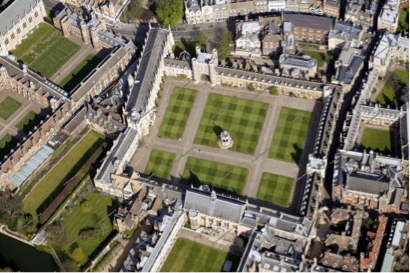
Readings
Part I: Concepts
-
Week 1 - Introduction: ‘Architectural Networks’
-
Week 2 - Carceral Archipelago and the Prison
-
Week 3 - Exhibitionary Complex and the Museum
Tony Bennett, “The Exhibitionary Complex.” The Birth of the Museum: History, Theory, Politics, 59-88. London; New York: Routledge, 1995.
Edward Said, Orientalism, 1-49. New York: Vintage Books, 1994. [If you do not have time to read this piece, watch the 1998 documentary
“Edward Said On Orientalism” on Youtube. 40 min. https://www.youtube.com/watch?v=3MYYDEj4fIU].
Wendy M. K Shaw, “Parallel Collections of Weapons and Antiquities,” and “The Rise of the Imperial Museum,” in Possessors and Possessed:
Museums, Archaeology, and the Visualization of History in the Late Ottoman Empire, 45-107. Berkeley: University of California Press, 2003.



-
Week 4 - The Library
Abigail A. Van Slyck, Free to All: Carnegie Libraries & American Culture, 1890-1920, Chicago: University of Chicago Press, 1995, 1-42. Chapter
1 previously published as: Abigail A. Van Slyck, “ ‘The Utmost Amount of Effectiv [sic] Accommodation’: Andrew Carnegie and the Reform of
the American Library,” Journal of the Society of Architectural Historians vol. 50, no. 4, 359-383. Dec., 1991.
Beatriz Colomina, “Archive,” Privacy and Publicity: Modern Architecture as Mass Media, 1-15. Cambridge, Mass.: MIT Press, 1996.


-
Week 5 - The Archive
Phyllis Lambert, “The Architectural Museum: A Founder’s Perspective,” Journal of the Society of Architectural Historians vol. 58, no. 3, 308‐
315. 1999.
Marlene Manoff, “Theories of the Archive from Across the Disciplines,” Libraries and the Academy vol. 4, no. 1, 9–25. 2004.
Jacques Derrida, trans. Eric Prenowitz, “Archive Fever: A Freudian Impression,” Diacritics vol. 25, no. 2, 9-63. Summer, 1995.



-
Week 6 - Cultural Capital
Pierre Bourdieu, “The Forms of Capital,” Handbook of Theory and Research for the Sociology of Education, edited by John G Richardson, 241-258.
New York: Greenwood, 1986.
Gary Stevens, Chapter 2 “The Sociological Toolkit of Bourdieu,” and Chapter 5 “Understanding Architectural Education,” The Favored Circle: The
Social Foundations of Architectural Distinction, 36-67; “CULTURAL CAPITAL” on p 62-63; 168-211. Cambridge, Mass: MIT Press, 1998.
Gary Stevens, “A History of Architectural Education in the West,” Available online at http://www.archsoc.com/kcas/Historyed.html.


Part II: Schools and Architecture
-
Week 7 - Educating the Public
Guest speaker: Tassos Anastassiadis
Dell Upton, “Lancasterian Schools, Republican Citizenship, and the Spatial Imagination in Early Nineteenth-Century America,” Journal of the Society
of Architectural Historians vol. 55, no. 3, 238-253. 1996.
Neil Briem Gislason, “Chapter 1: Building Paradigms: Major Transformations in School Architecture (1798-2009)” and “Chapter 2: Framing School
Design: Theory, Study Objectives, and Research Methods,” in School Design: History, Case Studies, and Practice, Dissertation, PhD in Education,
8-77. University of Toronto, 2009.
Carl Kaestle, “The Common School Reform,” Pillars of the Republic: Common Schools and American Society, 1780-1860, 104-135. New York: Hill
and Wang, 1983.
Dale Allen Gyure, “Part One: Buildings and Builders,” In The Transformation of the Schoolhouse: American Secondary School Architecture and
Educational Reform, 1880-1920. PhD in Architectural History, 16-109. University of Virginia, 2001.
Mark Dudek, "Part I A “Origins and Significant Historical Developments," Architecture of Schools: the New Learning Environments, 1-40. Oxford;
Boston: Architectural Press, 2000.





-
Week 8 - Educating "Others"
David Wallace Adams, “Chapter 4: Institution,” and “Chapter 5: Classroom,” In Education for Extinction: American Indians and the Boarding School
Experience, 1875–1928, 97-135; 136-163. Kansas: University Press of Kansas, 1995.
Geoffrey Paul Carr, “Chapter 1: Troubling Typologies of the Indian Residential School,” In ‘House of No Spirit’: An Architectural History of the Indian
Residential School in British Columbia, PhD in Art History, 42-81. University of British Columbia, 2011.
Barbara Reeves-Ellington, “Chapter 5: The Constantinople Home,” Domestic Frontiers: Gender, Reform, and American Interventions in the
Ottoman Balkans and the Near East, 140-165. University of Massachusetts Press, 2013.




-
Week 9 - Open Plan and Other Experiments
Brian Keating; T L Zani, “What is an open plan school?” and “Impact of Open Plan Schools,” In The Development of Open Plan Primary School Building
Design in Australia, 3-22; 40-44. West Perth, W.A.: Education Dept. of Western Australia, 1977.
Herman Hertzberger, Space and Learning: Lessons in Architecture, 22-73. Rotterdam: 010 Publishers, 2008.
Ivan Illich, Deschooling Society, 1-24. New York: Harper&Row, 1971.



Part III: College Campuses and their Design
-
Week 10 - The Expediency of the Campus
Jonathan Coulson, Paul Roberts, and Isabelle Taylor, “Chapter 1: University Planning and Architecture 1088-2010: A Chronology,” University
Planning and Architecture: The Search for Perfection.
Jeffrey Cody, “American geometries and the architecture of Christian campuses in China,” China’s Christian Colleges: Cross-cultural Connections,
1900-1950, edited by Daniel H. Bays and Ellen Widmer, 27-56. Stanford, Calif.: Stanford University Press, 2009.
Paul Turner, Campus: An American Planning Tradition . New York: The Architectural History Foundation, and Cambridge, Mas, and London: MIT
Press, 1984. Selection.
Thomas A. Dutton and Bradford C. Grant, “Campus Design and Critical Pedagogy,” Academe vol. 77, no. 4, 36-43. Jul. -Aug., 1991.



-
Week 11 - Modern University and the Modern City
Tomas Bender, ed., The University and the City: From Medieval Origins to the Present. “Part IV The Modern University and the Modern City” with contributions on University of Berlin, Basel, University of Chicago, The Institute of Social Research, and NYU.
Edward Shils, “The University, the City, and the World: Chicago and the University of Chicago,” 210-230. New York: Oxford University Press,
1988.
Martin Jay, “Urban Flights: The Institute of Social Research Between Frankfurt and New York.” 231-248.
Margaret Mary Grubiak, “Locating Religion on Campus” and “New Cathedrals for the Modern University". In White Elephants on Campus: The
Decline of the University Chapel in America, 1920-1960, 41-66; 67-94. University of Notre Dame Press, 2014.


-
Week 12 - Postwar University and the Military-Industrial Complex
Stefan Muthesius, “USA: Campus vs. College,” and “Campus Planning Worldwide,” The Postwar University: Utopianist Campus and College (Paul
Mellon Centre for Studies in British Art, 11-58; 247-280. New Haven; London: Yale University Press, 2000.
Reinhold Martin, “The MIT Chapel: An Interdiscursive History,” A Second Modernism: MIT, Architecture and the ‘techno-‐social’ Moment, edited by
Arindam Dutta, 72-105. MIT Press, 2013.
Burak Erdim, “Chapter Six: Rule of Experts: Designing the University and its Campus, 1956-59,” Middle East Technical University and Revolution:
Development Planning and Architectural Education during the Cold War, 1950-1962. University of Virginia PhD Thesis, pp. 351-434.




-
Week 13 - The City as School and the Anti-University
Samantha Hardingham and Kester Rattenbury, eds., Cedric Price: Potteries Thinkbelt. Abingdon: Routledge, 2007.
Karl Kiem, The Free University Berlin (1967-1973): Campus Design, Team X ideals and Tectonic Invention. Weimar: Verlag und Datenbank für
Geisteswissenschaften, 2008. Selection.
Gabriel Feld, ed., Free University, Berlin: Candilis, Josic, Woods, Schiedhelm. London: Architectural Association, 1999. Selection.




At McGill University School of Architecture
